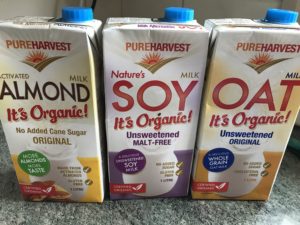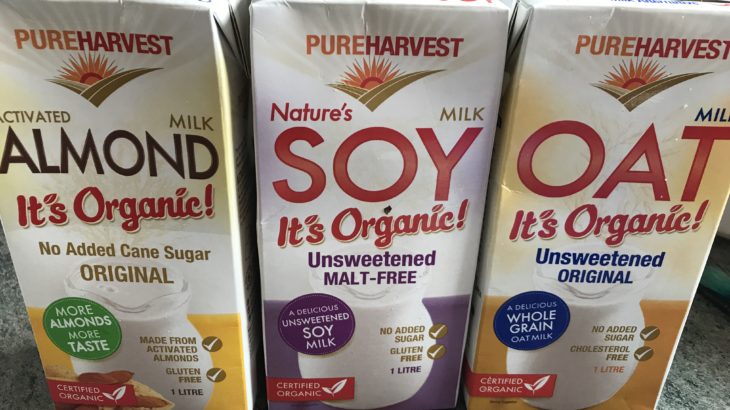A really common question I get asked as a naturopath is what sort of milk is best for my child to drink or have on their cereal. It often sparks vigorous debate among those who are in favour of plant based milks and those who prefer animal sources.
There are a few options and I will go through the pros and cons below so you can make up your own mind.
Cow’s milk: Most cow’s milk in Australia contains an A1 casein protein structure. To cut a long story short this protein has only been ingested by humans for the past 50 years (since the mass production of milk). You can read about this in another future blog post. It is linked to many different health conditions of the modern world such as heart disease, diabetes, and digestive discomfort (such as diarrhoea and bloating).
There have also been research studies looking at cow’s milk given to kids and babies, and many studies over the years have found that it causes intestinal bleeding in children when given under 12 months of age. This is not just as a sippy cup of milk, but all courses, including on their cereal. You can check out a review of this literature here: adc.bmj.com/content/archdischild/68/2/240.full.pdf (please note this link takes you to the PDF of the article)
There is a form of cow’s milk that is not as problematic as others. A2 milk is less allergenic than the A1 variety so if you choose cow’s milk – I recommend you choose A2. This can be the A2 milk brand, or any small dairy where you know that the cows are jersey cows (as a breed). Goat and Sheep’s milk are also A2 protein.
Almond milk: Almond milk is made when the almonds are pulverised and then then water is added. The solids are filtered out. Almonds are naturally high in calcium and magnesium so this can be a good substitute for cow’s milk, as well as being high in “good fats”, namely monounsaturated fatty acids and a smaller amount of polyunsaturated fatty acids.
However it obviously cant be used for children who have tree nut allergies to almonds.
It is also important to read the labels if you choose almond milk, as some brands add a lot of extras that are not necessary. One particular problematic one is Carrageenan. This is an extract from seaweed which is used as a thickener and stabiliser. It also has inflammatory properties and has been linked to cancer. It is a controversial area, however I would prefer not to take the risk and choose a brand that doesn’t contain it. Words in the ingredients list you need to look out for and avoid, are vegetable gum (407)’, ‘carrageenan gum’, or ‘vegetable gum (carrageenan).
Oat milk: Oat milk is a great choice for kids who don’t have Coeliac’s disease or are not sensitive to gluten as it is more palatable than some of the other plant based milks. As with the almond milk, it is advisable to check the ingredients to ensure it is not full of unnecessary items.
When I look at ingredient lists I compare brands and choose the one with the least amount of stuff in it. As an example, my current oat milk has water, oats, sunflower oil, and sea salt. Other brands have water, oats, corn maltodextrin, vegetable oils, sugar, minerals, acidity regulators, antioxidant, and natural flavour (plus a whole lot of synthetic vitamins and minerals added in). Simple is always better.
Rice milk: this can be a good choice for kids who are quite allergic in presentation. They may be sensitive to dairy, gluten and nuts and so this will rule out everything I have listed above. Rice is low allergy and gentle on the digestive system. One point to note is that you want to look at the country of origin and place of manufacture. Often rice grown in china is high in pollutants, as the soil and air are not as clean as it is here in Australia, so I always choose Australian made and grown if I can. Organic is even better
Soy milk: this is probably the most controversial aspect of choosing milk as some paediatricians recommend soy for children and some children are dinking soy based formula due to allergies to other foods. I prefer not to drink soy milk and don’t recommend it for children due to the concentration of phytoestrogens in it. Soy milk is a very potent product. It takes many soy beans to make a litre of soy milk. This concertation of phytoestrogens is very high – great for premenopausal women, not so great for kids.
There are a few factors that amplify this:
- children have a much smaller body size than adults. A glass of soy milk for a child vs an adult is quite different.
- As a society we are also exposed to a lot of oestrogen mimickers in plastics. Even if you avoid BPA, how many kids have plastic toys that they put in their mouths, as well as eating off plastic plates and bowls, and drinking out of plastic cups and bottles? These oestrogen mimickers are very similar to phytoestrogens. They build up in the body and have been linked to oestrogen dominant cancers, such as breast cancer as well as fertility issues.
So, I choose to reduce plastic exposure as well as soy milk exposure. Other soy products such as tofu and tempeh are not as problematic as they are not as concentrated, however I wouldn’t choose soy products as the main source of protein in a child’s diet either.
Coconut milk: this is a fantastic source of good fats. It often has a bad reputation as it is high in saturated fat, however the form of saturated fat is called a “medium chain fatty acid” (MCFA) which is converted to energy more readily in the body unlike other saturated fat. This MCFA also has anti-viral and anti-bacterial properties. So it may be helpful to drink coconut milk if you and your kids are constantly catching viruses. Finally, it is also high in magnesium which is great for bone health.
It may not be practical to open a can of coconut milk to pour on to breakfast cereal so there are tetra packs of coconut milk in the supermarket. As with all other plant milks – please read the ingredients as often it is blended with other milks. For example, some brands you are paying for mostly rice milk with a splash of coconut, and yet they still call it coconut milk. I will often used tinned coconut milk when baking cakes so that they can be dairy free and nut free. I usually use half the milk quantity as coconut milk and half water (or occasionally full coconut milk, which will give cakes a really creamy, rich quality)
So there you have it – a summary of the most popular milk choices around. I hope this helps you to make an informed decision. I welcome your questions below. Let me know what you think in the comments too.
